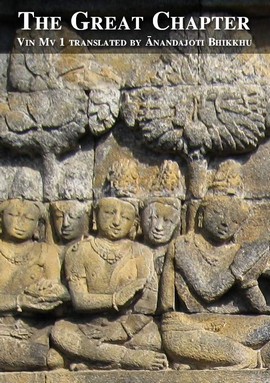eBooks

Text and Study
Text and Translation
Html Table of Contents (outline)
Html Table of Contents (detail)
1: The Story about the Awakening (Tree) (Conditional Origination)
2: The Story about the Goatherd’s (Tree) (The Grumbling Brāhmaṇa)
3: The Story about the Mucalinda (Tree)
4: The Story about the Royal (Tree) (Tapussa and Bhallika)
5: The Story about Brahma’s request
[9: The Discourse Setting the Dhamma-Wheel Rolling]
[11: The Discourse about the Characteristic of Non-Self] (The First Arahants)
[14: Yasa’s Mother and his Former Wife]
15: The Going-Forth of (Yasa’s) Four Householder Friends
16: The Going-Forth of the Fifty Householder Friends
18: The Story of Full Ordination through Going to the Three Refuges
19: The Second Story about Māra
20: The Tale of the Good Group of Friends
21: The First Miracle (The Dragon-king - Prose)
22: The First Miracle (The Dragon-king - Verse)
23: The Second Miracle (The Four Great Kings)
24: The Third Miracle (Sakka, the Lord of the Gods)
25: The Fourth Miracle (Brahmā Sahampati)
26: The Fifth Miracle (Mind-Reading)
[30: The Emblic Myrobalan Miracle]
[31: The Yellow Myrobalan Miracle]
[32: The Coral Tree Flower Miracle]
[33: The Sacred Fire Miracles]
[36: The Ordination of Kassapa and his Followers]
[37: The Ordination of the Other Yogis]
38: The Instruction About Burning
39: The Meeting with King Bimbisāra
[40: The Donation of the Bamboo Wood]
41: The Story of the Going-Forth of Sāriputta and Moggallāna
42: The Going-Forth of the Well-Known (Sons of Good Families)